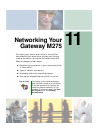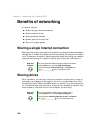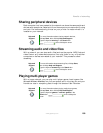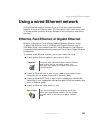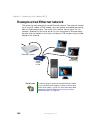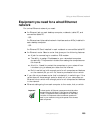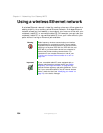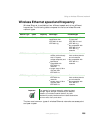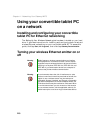
205
Using a wireless Ethernet network
www.gateway.com
Wireless Ethernet speed and frequency
Wireless Ethernet is available at two different speeds and at two different
frequencies. The following table compares the various wireless Ethernet
network types.
The two most common types of wireless Ethernet networks are access point
and peer-to-peer.
Network Type Speed Frequency Advantages Disadvantages
IEEE 802.11a 54 Mbps 5 GHz Less possible
interference than
IEEE 802.11b and
IEEE 802.11g
■
Shorter range (25 to
75 feet) than
IEEE 802.11b and
IEEE 802.11g
■
Not compatible with
IEEE 802.11b or
IEEE 802.11g
networks
IEEE 802.11b 11 Mbps 2.4 GHz
■
Large number of
access points already
exist in airports,
college campuses, and
businesses
■
Compatible with
IEEE 802.11g
networks
■
Longer range (100 to
150 feet) than
IEEE 802.11a
■
Possible interference
from cordless phones
and microwaves
■
Not compatible with
IEEE 802.11a
networks
IEEE 802.11g 54 Mbps 2.4 GHz
■
Compatible with
IEEE 802.11b
networks
■
Longer range (100 to
150 feet) than
IEEE 802.11a
■
Possible interference
from cordless phones
and microwaves
■
Not compatible with
IEEE 802.11a
networks
Important The speed of a wireless network is related to signal
strength. Signal strength is affected by the distance
between your wireless network devices, by radio
interference, and by interference from natural obstructions
such as walls, floors, and doors.



